Research on Ecological Effect Assessment Method of Ecological Restoration of Open-Pit Coal Mines in Alpine Regions
Abstract
:1. Introduction
2. Materials and Methods
2.1. Study Area
2.2. Research Methods
2.2.1. Fractional Vegetation Cover
2.2.2. Net Primary Productivity
2.2.3. Soil Erosion
2.2.4. Carbon Sequestration Effect
3. Results
3.1. Ecological Project Area
3.2. Ecological Impact Area
4. Discussion
4.1. Intuitiveness and Effectiveness of the Multi-Scale and Multi-Dimensional Ecological Restoration Effect Assessment Model of Alpine Open-Pit Coal Mine for Ecological Restoration Effect Evaluation
4.2. Limitations and Future Research Directions
5. Conclusions
- (1)
- The multi-scale and multi-dimensional ecological restoration effect assessment model of an alpine open-pit coal mine can intuitively and effectively reflect whether the ecological restoration projects have achieved the effect of maintaining, improving, and enhancing the service capacity of the regional ecosystem and provide a scientific basis for the ecological restoration and green development of open-pit coal mines in alpine regions.
- (2)
- According to the interpretation and analysis of remote sensing, the total area of the dump site of the Baiyinhua No. 2 Open-pit Mine is 16.02 km2, of which the total area of the ecological restoration project is 6.85 km2 and the restoration rate is 55.96%. In the ecological project area, the overall fractional vegetation cover and carbon sequestration showed an increasing trend. The fractional vegetation cover of each project area gradually increased with the passage of the growing season. In the ecological impact area, the overall vegetation coverage, net primary productivity, and carbon sequestration all showed an increasing trend, and the soil erosion modulus also decreased to a certain extent. The ecosystem service capacity of the Baiyinhua No. 2 Open-pit Mine is in the situation of maintenance, improvement, and enhancement. The above results further prove the effectiveness of the Baiyinhua No. 2 Open-pit Mine ecological restoration.
Author Contributions
Funding
Institutional Review Board Statement
Informed Consent Statement
Data Availability Statement
Conflicts of Interest
References
- Li, S.Z.; Li, X.L. Several basic issues of ecological restoration of coal mines under background of carbon neutrality. Coal Sci. Technol. 2022, 50, 286–292. (In Chinese) [Google Scholar]
- Zhao, Y.; Xie, J.L.; Chen, C.; Li, Y.F. Research on life cycle ecological environment protection and management in open-pit coal mine. Opencast Min. Technol. 2021, 36, 65–67. (In Chinese) [Google Scholar]
- Liu, M.W. Application of ecological restoration technology in open-pit coal mine in the new period. Sci. Technol. Innov. 2021, 30, 139–141. (In Chinese) [Google Scholar]
- Wang, T.; Du, B. Ecological environment rehabilitation management model and key technologies in plateau alpine coal mine. J. China Coal Soc. 2021, 46, 230–244. (In Chinese) [Google Scholar]
- Pan, Y.; Wang, L.C. Assessment of Restoration Effects of Abandoned Mining Lands in Mufushan Mountain Based on Ecosystem Value. Res. Soil Water Conserv. 2019, 26, 180–186. (In Chinese) [Google Scholar]
- Xia, X.D. Construction of Evaluation Index System for Ecological Restoration of Lead Zinc Tailings Verification Study. Master’s Thesis, Lanzhou Jiaotong University, Lanzhou, China, 2017. [Google Scholar]
- Zhou, J. Ecological Restoration Effect Evaluation of Dalian Limestone Mine Pit Slope. Master’s Thesis, Liaoning Normal University, Dalian, China, 2012. [Google Scholar]
- Huang, D.; Liu, Q.S. Remote Sensing Monitoring and Effect Evaluation on Ecological Restoration of Heidaigou Coal Mining Area. J. Remote Sens. Technol. Appl. 2014, 29, 69–74. (In Chinese) [Google Scholar]
- Krabbenhoft, K.; Kriby, D. Topoedaphic Unit Analysis: A Site Classification System for Reclaimed Mined Lands. CATENA 1993, 20, 289–301. [Google Scholar] [CrossRef]
- Ma, C.A.; Wang, Q.R. Ecological Evaluation Model for Large Opencast Mine and Its Application. J. Min. Saf. Eng. 2006, 4, 446–451. (In Chinese) [Google Scholar]
- Hu, Z.Q.; Xiao, W. Some thoughts on green development strategy of coal industry: From aspects of ecological restoration. Coal Sci. Technol. 2020, 48, 35–42. (In Chinese) [Google Scholar]
- Jiang, W.C.; Yang, J.Q. Research Progress of Mine Ecological Restoration. Min. Res. Dev. 2022, 42, 127–132. (In Chinese) [Google Scholar]
- Liang, C.M.; Cao, Q.Y. Construction of ecological restoration evaluation index system including mountains-rivers-forests-farmlands-lakes-grasslands: Taking Tongchuan City as an example. China Energy Environ. Prot. 2021, 43, 105–113. (In Chinese) [Google Scholar]
- Hasi, Q.Q.G. The Rational Thinking on the Exploitation and Utilization of Xilingol Coalfield: A Case Study on the Opencast Coal Mine of Bai Yinhua-II. Master’s Thesis, Inner Mongolia Normal University, Hohhot, China, 2011. [Google Scholar]
- Chun, F.; Yu, S. Variability of Aboveground Biomass and Interspecific Compensatory Effect of Grassland Communities in Baiyinhua Mining Area, Inner Mongolia, China. Acta Agrestia Sin. 2021, 29, 1533–1539. (In Chinese) [Google Scholar]
- Chun, F.; Bao, G. Composition and spatial distribution of main species in grassland community of Baiyinhua mining area, China. Chin. J. Appl. Ecol. 2020, 31, 3395–3403. (In Chinese) [Google Scholar]
- Luo, L.; Ye, G.Y. Changes of Vegetation Coverage and Landscape Pattern in Jinchuan Mining Area: A Study under the Ecological Restoration. J. Subtrop. Resour. Environ. 2022, 17, 64–71. (In Chinese) [Google Scholar]
- Zhao, J.J.; Lu, M.X. Study on the Ecological Restoration of Mining Area Based on the Change of Vegetation Coverage. Min. Res. Dev. 2018, 38, 115–118. (In Chinese) [Google Scholar]
- Li, M.M.; Wu, B.F. Estimation of vegetation fraction in the upper basin of Miyun reservoir by remote sensing. Resour. Sci. 2004, 4, 153–159. (In Chinese) [Google Scholar]
- Li, Z.X.; Zhang, Y.F. Response of net primary productivity of vegetation to land cover change in six coal fields of Shanxi province. China Min. Mag. 2021, 30, 107–114. (In Chinese) [Google Scholar]
- Tian, W.T.; Hu, W.Y. The Status of Soil and Water Loss and Analysis of Countermeasures in China. Res. Soil Water Conserv. 2008, 15, 204–209. (In Chinese) [Google Scholar]
- Zhou, X.F.; Ma, G.X. Soil erosion changes in Jiangxi Province from 2001 to 2015 based on USLE model. Bull. Soil Water Conserv. 2018, 38, 8–11, 17. (In Chinese) [Google Scholar]
- Qi, S.H.; Jiang, M.X. Evaluating soil erosion in Jiangxi Province with USLE model and remote sensing technology during 1995~2005. China Environ. Sci. 2011, 31, 1197–1203. (In Chinese) [Google Scholar]
- Zhu, K.; Peng, J.S. Ecological Benefits and Value Evaluation of Carbon Fixation and Oxygen Release in Qujing City. For. Eng. 2022, 38, 34–43. (In Chinese) [Google Scholar]
- An, Y.; Bi, L.F. Jiangxi famous source nature reserve forest sequestration releasing oxygen and transformation of solar energy value accounting. Jiangxi Sci. 2011, 29, 59–61. (In Chinese) [Google Scholar]
- Liu, L.Y. Research on Ecological Resources Evaluation and Environmental Protection in Dongjiang Source Area, 1st ed.; Jiangxi Science and Technology Press: Nanchang, China, 2006. (In Chinese) [Google Scholar]
- Teli, G.E.; Naren, M.D.L. Land desertification and its response to climate factors in Xilingol League from 2000 to 2019. J. Chifeng Univ. (Nat. Sci. Ed.) 2021, 37, 42–47. (In Chinese) [Google Scholar]
- Zhang, S.L.; Zhu, L.J. Mine ecological restoration from the perspective of “economic, political, cultural, social and ecological progress”. J. Environ. Protection. 2014, 42, 72–74. (In Chinese) [Google Scholar]
- Cao, Y.; Wang, J.Y. Ecological restoration for territorial space: Basic concepts and foundations. China Land Sci. 2019, 33, 1–10. (In Chinese) [Google Scholar]
- Bai, Z.K.; Zhou, W. Overall protection, systematic restoration and comprehensive management of land space. China Land Sci. 2019, 33, 1–11. (In Chinese) [Google Scholar]
- Hua, M.; Yuan, L. Complexity of ecological restoration in China. Ecol. Eng. 2013, 52, 75–78. [Google Scholar]
- Wang, M.H. Study on Comprehensive Standardization of Land Reclamation and Ecological Restoration in Mining Areas. Master’s Thesis, China University of Geosciences, Beijing, China, 2019. [Google Scholar]
- Ju, J.H. Building the support system of green mine construction in China. China Min. Mag. 2020, 29, 13–15. (In Chinese) [Google Scholar]
- Wang, W.J.; Lu, F. Carbon-neutral contribution of ecological restoration in Beijing’s territorial space. Beijing Plan. Rev. 2021, 5, 22–26. (In Chinese) [Google Scholar]
- Chen, S.Y.; An, W.S. Decisive factors impacting the carbon sequestration in mangrove ecological restoration. J. Appl. Oceanogr. 2021, 40, 34–42. (In Chinese) [Google Scholar]
- Bian, Z.F.; Yu, H.C. Solutions of mine ecological restoration under carbon neutrality. J. China Coal Soc. 2022, 47, 449–459. (In Chinese) [Google Scholar]
- Yin, Y.; Xi, F.M. The current situation and development trend of Chinese mine ecological environment restoration under the background of “carbon neutral”. Ind. Miner. Process. 2022, 1–8. (In Chinese) [Google Scholar]
- Guo, D.Y.; Yang, F. Policy suggestions for mine ecological restoration contributing to carbon neutrality. Nat. Resour. Econ. China 2021, 34, 50–54. (In Chinese) [Google Scholar]
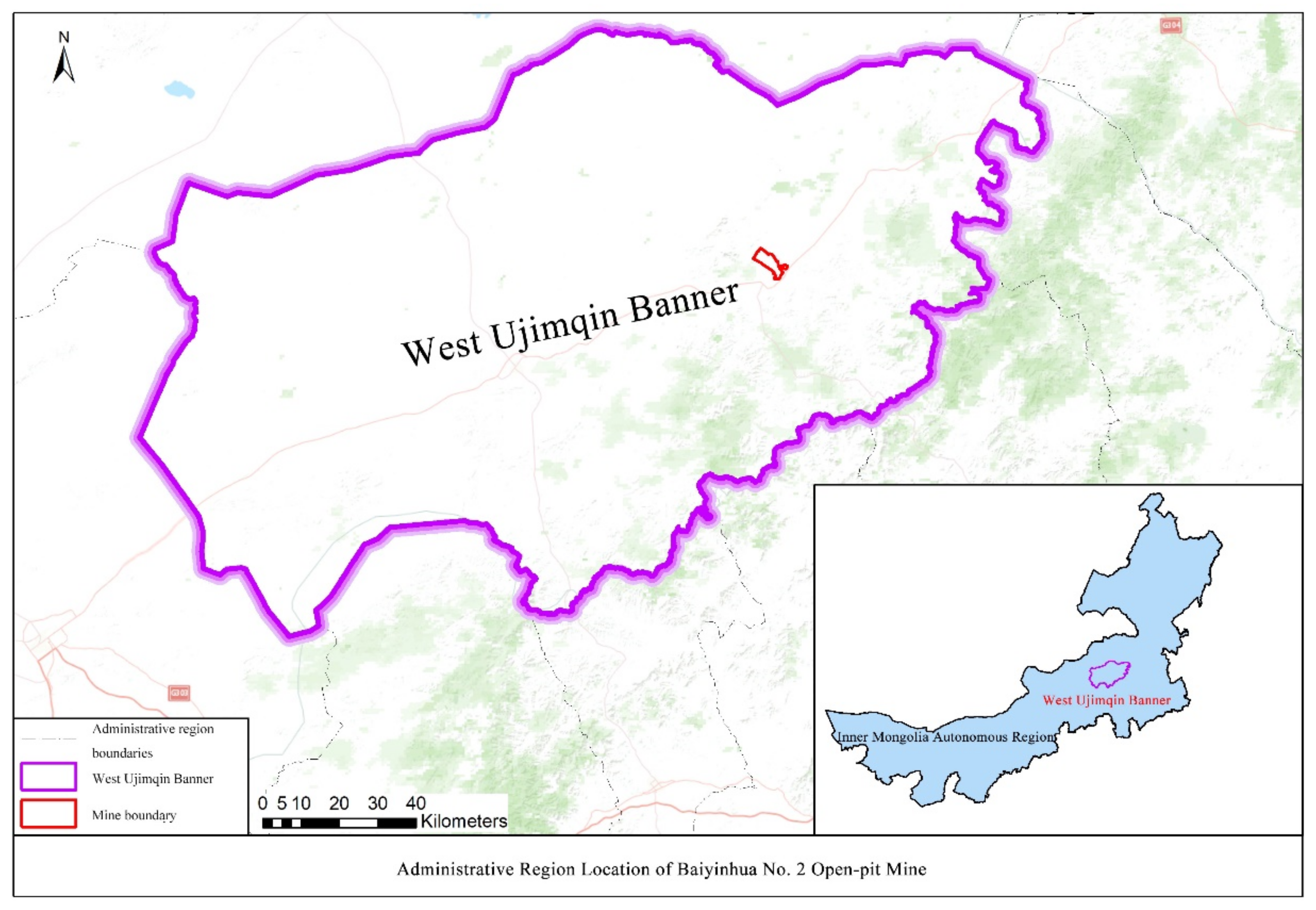
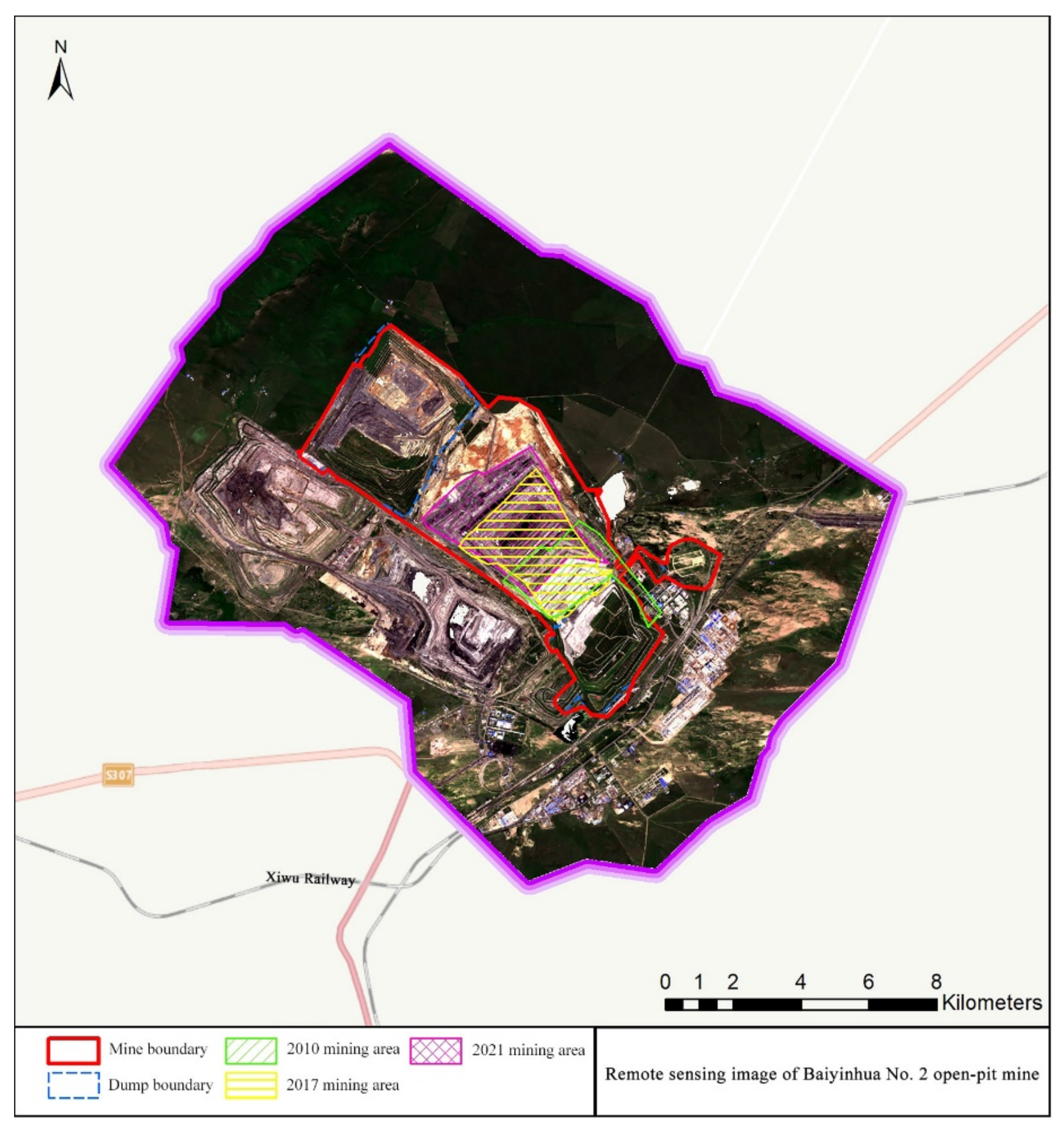
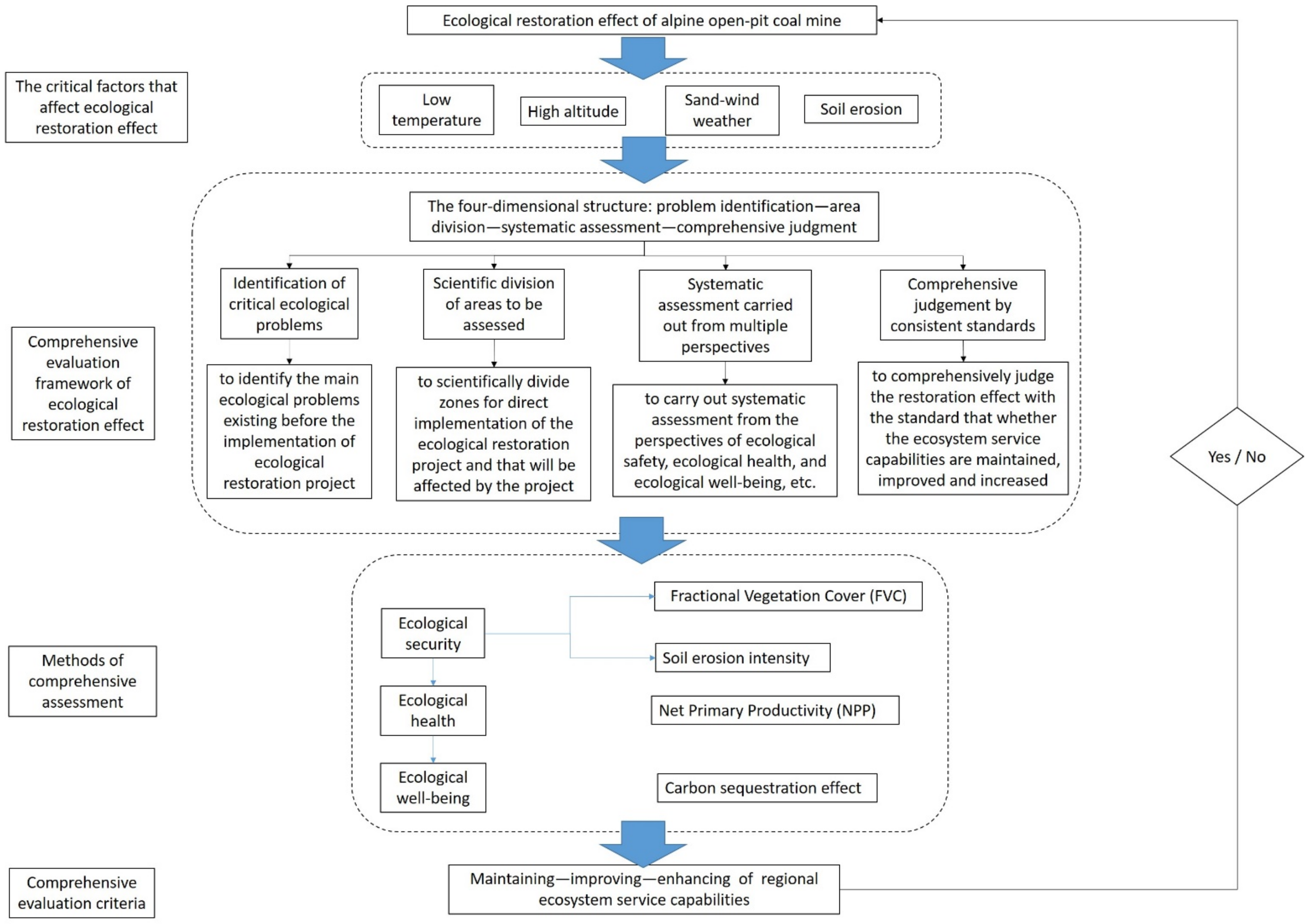
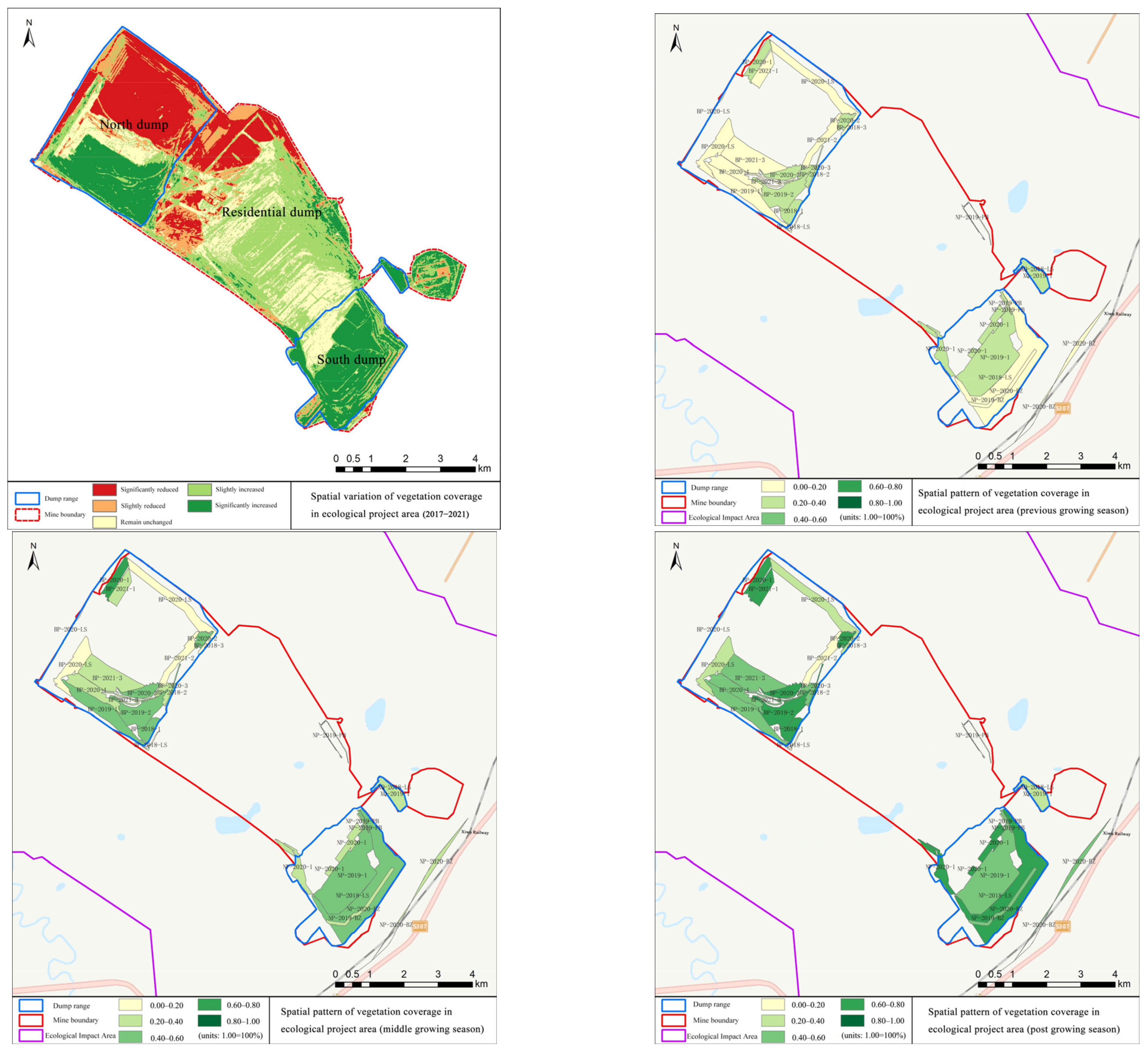
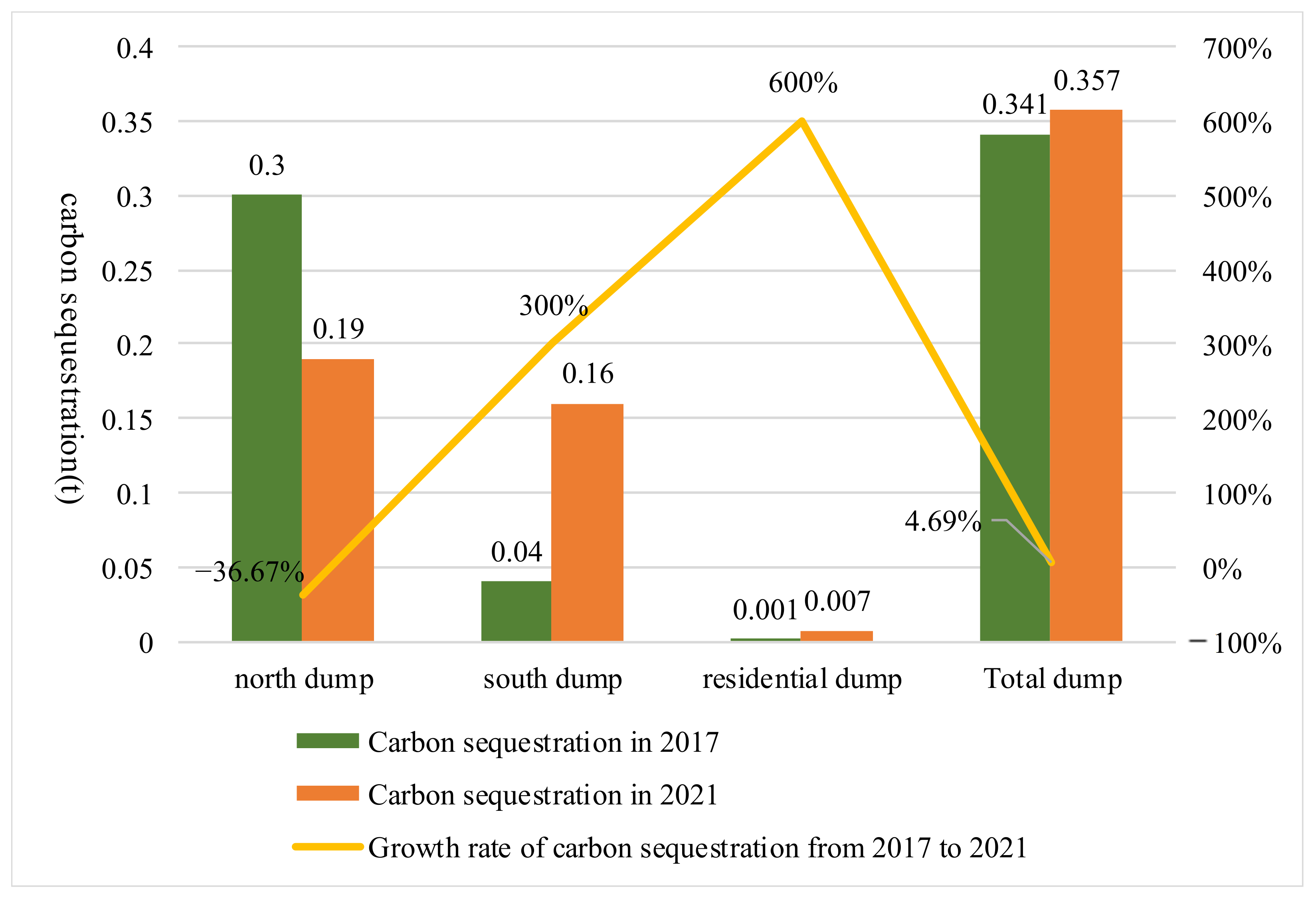

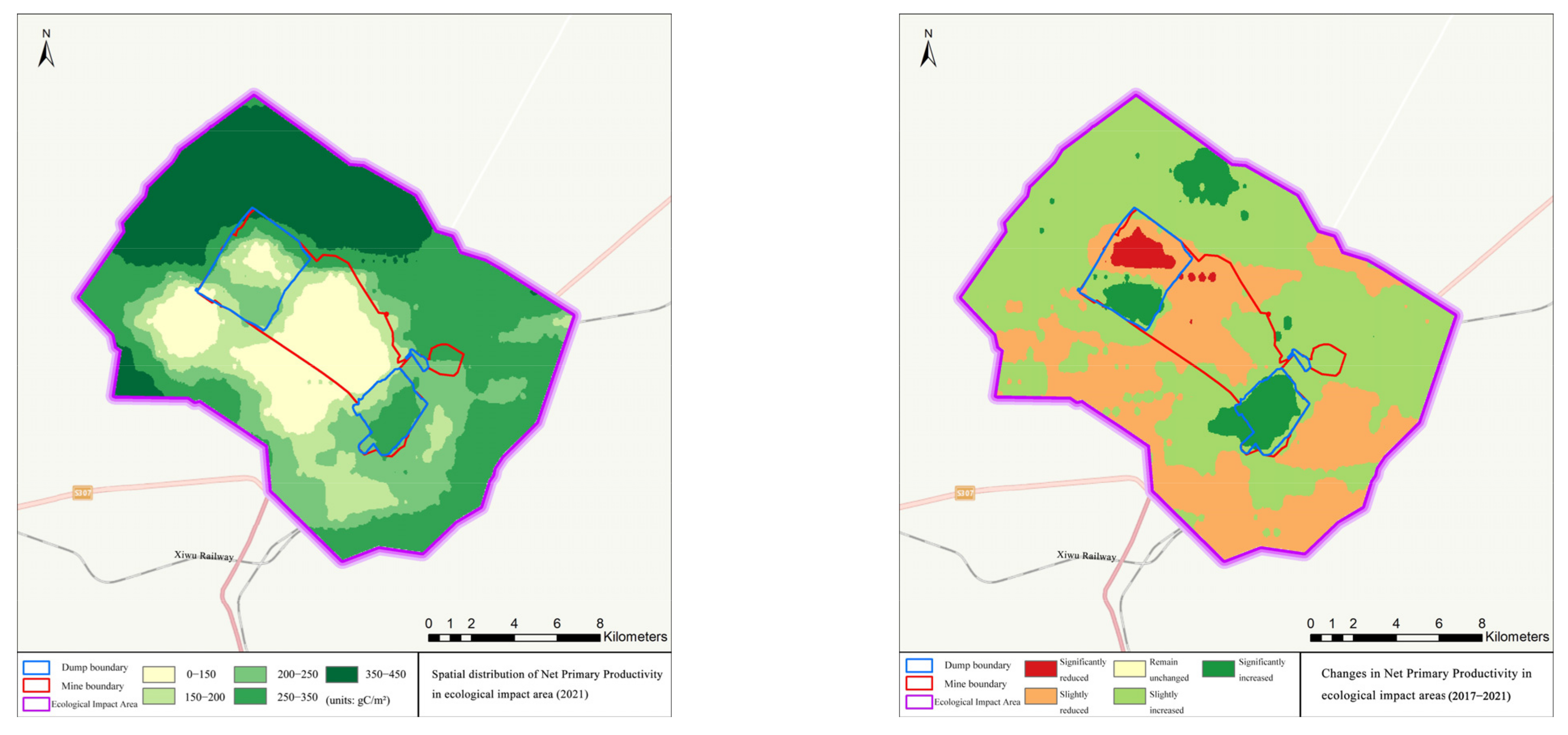
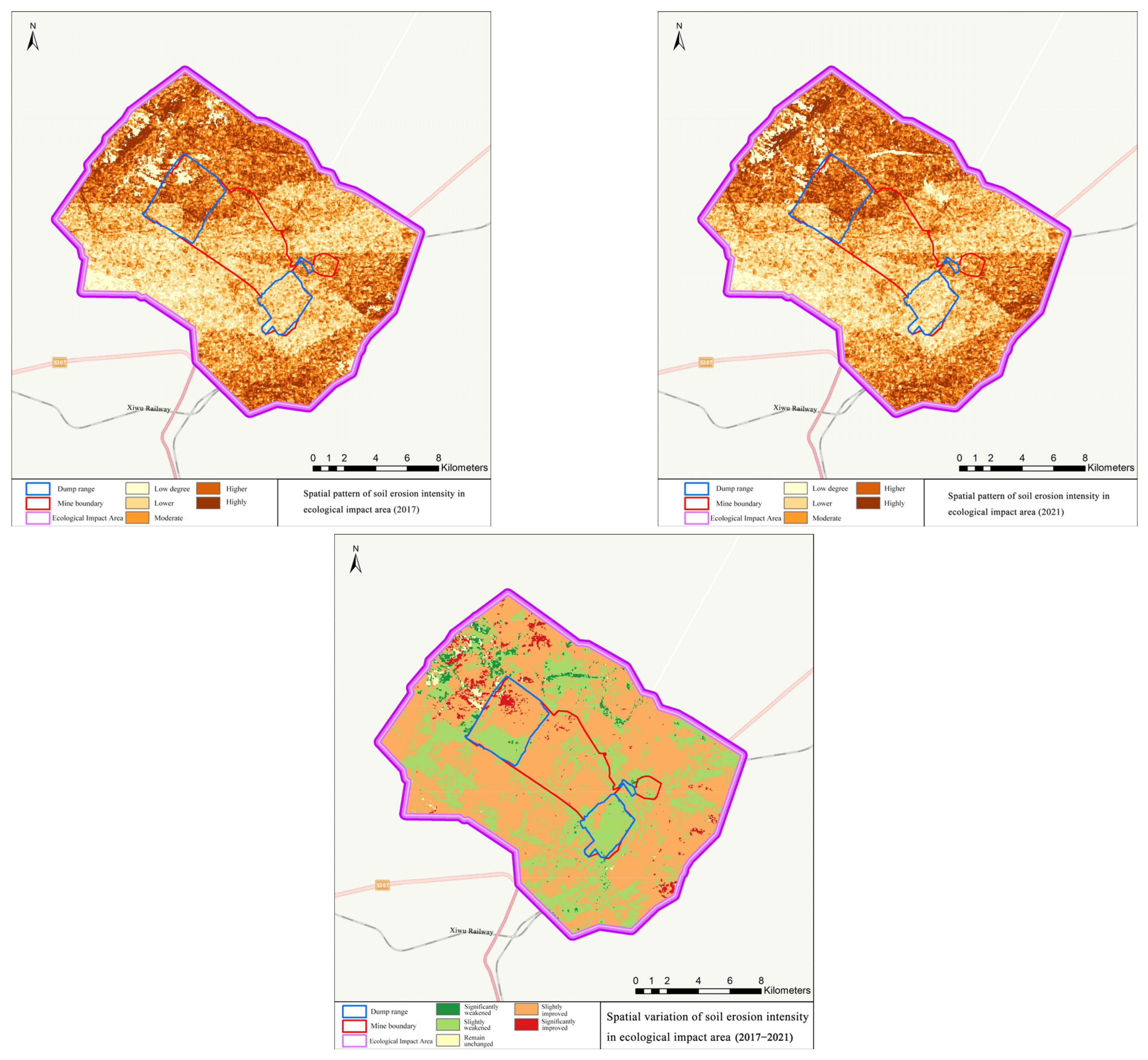
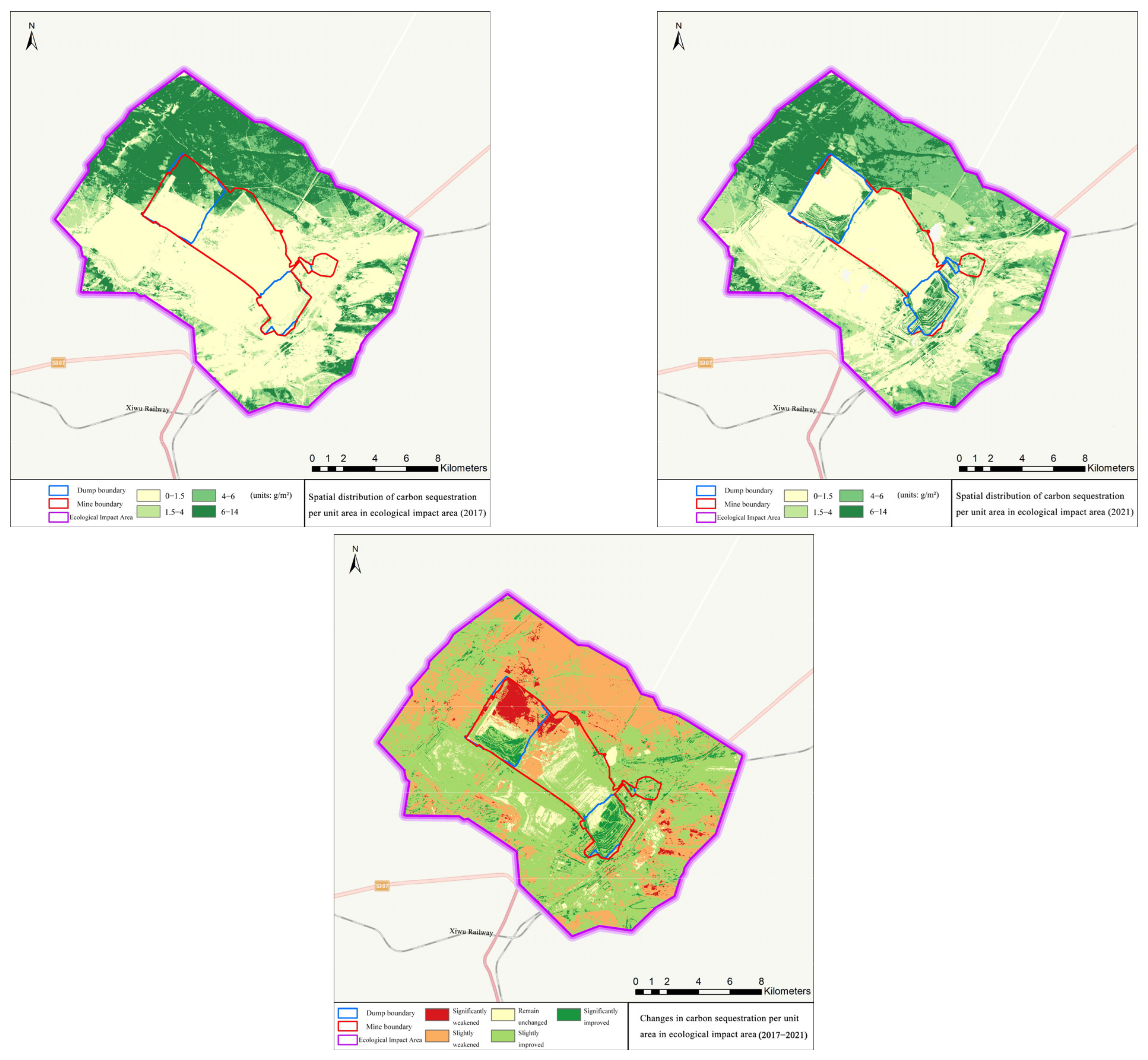
Publisher’s Note: MDPI stays neutral with regard to jurisdictional claims in published maps and institutional affiliations. |
© 2022 by the authors. Licensee MDPI, Basel, Switzerland. This article is an open access article distributed under the terms and conditions of the Creative Commons Attribution (CC BY) license (https://creativecommons.org/licenses/by/4.0/).
Share and Cite
Yuan, M.; Ouyang, J.; Zheng, S.; Tian, Y.; Sun, R.; Bao, R.; Li, T.; Yu, T.; Li, S.; Wu, D.; et al. Research on Ecological Effect Assessment Method of Ecological Restoration of Open-Pit Coal Mines in Alpine Regions. Int. J. Environ. Res. Public Health 2022, 19, 7682. https://doi.org/10.3390/ijerph19137682
Yuan M, Ouyang J, Zheng S, Tian Y, Sun R, Bao R, Li T, Yu T, Li S, Wu D, et al. Research on Ecological Effect Assessment Method of Ecological Restoration of Open-Pit Coal Mines in Alpine Regions. International Journal of Environmental Research and Public Health. 2022; 19(13):7682. https://doi.org/10.3390/ijerph19137682
Chicago/Turabian StyleYuan, Meng, Jingyi Ouyang, Shuanning Zheng, Ye Tian, Ran Sun, Rui Bao, Tao Li, Tianshu Yu, Shuang Li, Di Wu, and et al. 2022. "Research on Ecological Effect Assessment Method of Ecological Restoration of Open-Pit Coal Mines in Alpine Regions" International Journal of Environmental Research and Public Health 19, no. 13: 7682. https://doi.org/10.3390/ijerph19137682
APA StyleYuan, M., Ouyang, J., Zheng, S., Tian, Y., Sun, R., Bao, R., Li, T., Yu, T., Li, S., Wu, D., Liu, Y., Xu, C., & Zhu, Y. (2022). Research on Ecological Effect Assessment Method of Ecological Restoration of Open-Pit Coal Mines in Alpine Regions. International Journal of Environmental Research and Public Health, 19(13), 7682. https://doi.org/10.3390/ijerph19137682





